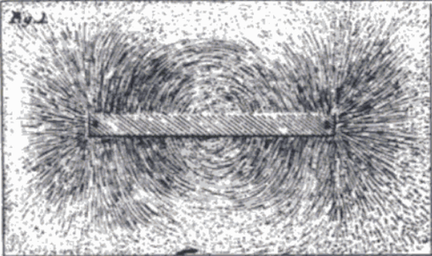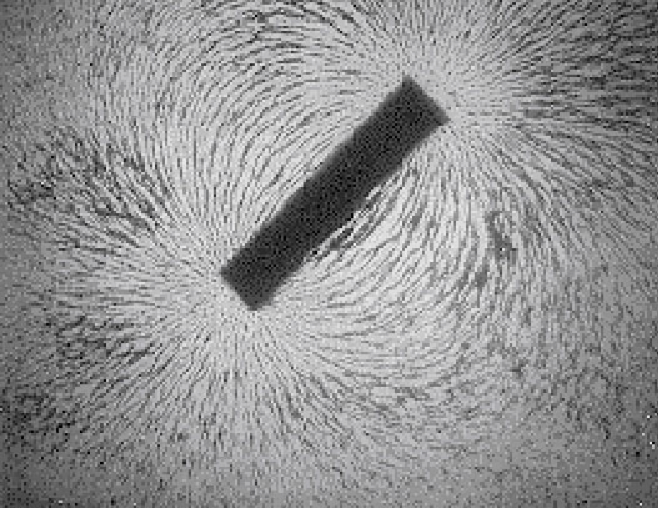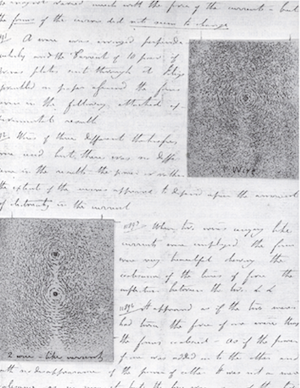12.4. The Field#

Look carefully at the figure just above and the figure to the right, the proverbial 1000-words’-worth kind of pictures. The first is from Faraday’s notebook, and so a sketch made by him sometime in the early 1830’s. The second is a photograph from our lecture hall. What you see is a bar magnet surrounded by little bits of iron filings, each a little magnet of its own. By tapping the surface one frees them from any friction with the surface and they respond to an unseen presence—what Faraday called “lines of force.”

One really cannot help but be mesmerized by this picture when you think about what it suggests. At first Faraday used the image of “lines of force” as a visualization…but by 1831 (in his diary) and 1845 in public and in print, he began to speak of the reality of what he coined a “field.” While a compass points north, responding to an apparently invisible quality, these pictures revealed to Faraday that there’s something there, hidden from view. Like a ghost materializing out of thin air in a Halloween cartoon, these lines of force reveal themselves by their spooky influence on the iron filings.
Faraday, like everyone, had trouble with Newton’s action at a distance – that one body could reach out and influence another body with nothing in-between. But the scientific community – especially those in Newton’s Britain – and come to peace with instantaneous, Action at a Distance.
But his simple experiment shows that there’s something there. Faraday played with this idea for years but slowly became committed to the reality of the lines of force – that empty space was not empty at all, but full of this almost material substance that seemed to propagate magnetic influence from one place to another. Faraday was aware that these were not going to be popular notions. First these lines of force were not Newtonian in character – they curved. They were circular. Maybe even worse: they seemed to endow space itself with something to do. In the Newtonian way of thinking, all space did was establish “place.” It just defined separations between objects and staked out occupied regions. But Faraday’s lines of force, if real, filled all of space. The effects of magnetism required space-filling lines of force. Or so his ideas went. But he didn’t publish these ideas.
Instead, for years he amassed his evidence. Look at figure below, again from his notebooks. Here we see the cross section of a wire (top) and two wires (bottom) all carrying currents. Iron filings were sprinkled on the sheet of paper punctured by the wires and again, by their orientation and arrangements, the filings signal the presence of magnetic lines of force. From the Oersted experiment, he knew that a current creates a magnetic effect and here he’s shown it to be of the same sort of disturbance as from a bar magnet. It was time to come clean.

Finally, in 1837 he read what was the 11th of a series of Experimental Researches in Electricity to the Royal Society and he proposed that rather than being just a mental crutch, perhaps the lines of force were real. This was a frontal assault on (British) scientific belief and the reaction was not pleasant. In particular in the audience was the young William Thomson (the future Lord Kelvin), who was disgusted with the idea. Until he worked on it. What Thomson did was to apply the mathematics of heat conduction to the “streamlines” of Faraday’s lines of force. He found that it hung together and by 1845, when he first actually met Faraday, he proposed that magnetic forces might actually affect the passage of light through materials.
Faraday set out to try to observe Thomson’s effect, obviously encouraged that someone who was of the traditional scientific establishment, and a mathematical person to boot, would take his ideas seriously. He worked feverishly without results for almost a week, until he found the effect, which is today called the Faraday Effect: the presence of a magnet affects the polarization of light in some materials.
Aha. A magnetic disturbance affecting the propagation of light…were they connected?
Please answer Question 6 for points:
Please answer Question 7 for points:
12.4.1. The Ether#
Light is an undulatory phenomenon – it’s a wave. For his colleagues the idea of light propagating through a vacuum was ludicrous. There had to be something “waving” for the light beams to undulate. In the classic sense of naming something being satisfying, but not really explaining, this “something” was called the Ether…specifically, the “Luminiferous Ether” for the Ether that propagated light (there were thought to be other ethers that propagated electricity and magnetism).
The Luminiferous Ether was a strange beast: It was everywhere. It didn’t impede the motion of the Earth. It couldn’t be seen, felt, tasted, or nudged and yet it could delicately react to light which stretched and compressed it as it propagated from one place to the other. Yet, since the speed of light was known to be very fast, the ether would have to be stiffer than steel to vibrate at that rate! The idea is very strange. Too much so for Faraday whose views on space were extreme. He had no time for this unrealistic, invisible ether. Rather than imaging space to be just a big container that keeps everything from being all in the same place(!), he imagined a space that was full of electric and magnetic lines of force.
For example his induction experiment could be explained this way. Look again at the figure above of the coil and the approaching magnet. As the magnet approaches the patiently waiting, inert coil of wire, more and more lines of flux are “cut” (his word) by the wire and it’s the cutting of the “flux” (his word) that starts the current to flow. In fact, he even imagined that this magnetic flux would take time to reach the wire, so it was not instantaneous. Were a wire to be parallel to the lines of force, there would not be any current. Only when the lines of force cut a wire, would current flow.
After that public exposure, Faraday tried to be more specific in a letter to Philosophical Magazine.
“The propagation of light and therefore probably of all radiant action, occupies time; and, that a vibration of the line of force should account for the phaenomena [sic] of radiation, it is necessary that such a vibration should occupy time also…I think it is likely that I have made many mistakes in the preceding pages, for even to myself, my ideas on this point appear only as the shadow of a speculation, or as one of those impressions on the mind which are allowable for a time as guides to thought and research. He who labours in experimental inquiries knows how numerous these are, and how often their apparent fitness and beauty vanish before the progress and development of real natural truth.”
He was roundly criticized for this speculation. He chalked it up to his learned colleagues being overly cautious and hide-bound to their preconceptions. His colleagues basically indicated that Faraday was a brilliant experimenter, but out of his depth when he ventured into speculative ideas about nature and mathematics. Faraday needed a hero and we’ll meet his champion in the next chapter.
Please answer Question 7 for points: